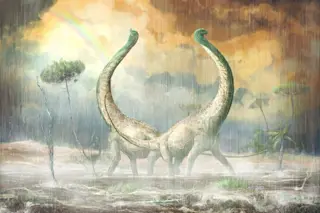Hailing from East Africa, the newly described giant, plant-eating dinosaur Mnyamawamtuka moyowamkia lived around 100-110 million years ago, during the middle of the Cretaceous. The animal, a member of the titanosaur lineage, is helping paleontologists understand how, where and when the mightiest of land animals evolved.
Sauropodomorphs are some of the most common and geographically diversely dinosaurs in the fossil record, and their shape — small head, long neck, big torso, elephant-like limbs and a long tail — is one of the most iconic body plans, instantly recognizable even to people who don’t care about dinosaurs (perish the thought!).
The basic body plan of sauropodomorphs, including titanosaurs, is so recognizable that companies such as Sinclair Oil Corporation have used it in logos, where an instant read is everything. Yes, I know the Sinclair mascot is depicted as a tail-dragger, now known to be anatomically incorrect. Complain to them, not me, ...














